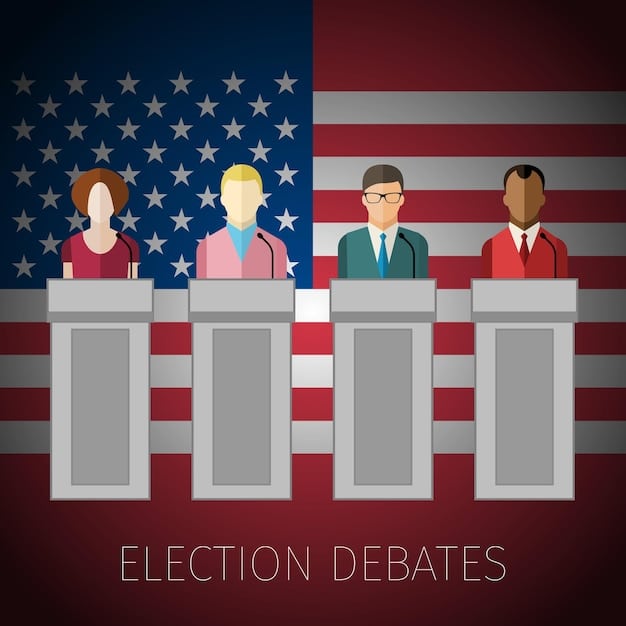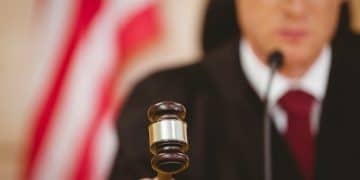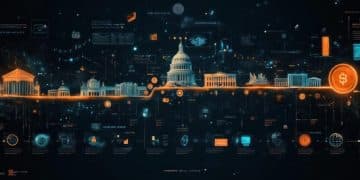Analyzing Presidential Approval Ratings: Factors & Impact on Policy

Analyzing the President’s Approval Ratings: What Factors Are Driving Public Opinion and How Will It Impact Policy? involves examining various elements like economic conditions, social events, and political decisions to understand public sentiment and predict potential policy shifts, affecting governance and future elections.
Understanding presidential approval ratings is crucial for gauging the political landscape and anticipating policy changes. Analyzing the President’s Approval Ratings: What Factors Are Driving Public Opinion and How Will It Impact Policy? provides insights into the complex interplay of elements that shape public sentiment and influence presidential actions.
Understanding Presidential Approval Ratings
Presidential approval ratings serve as a barometer of public sentiment towards the president and their administration. These ratings reflect the degree to which the public approves or disapproves of the president’s performance in office. Understanding these ratings involves delving into the methodologies used to calculate them and the various factors that contribute to their fluctuations.
The process of measuring presidential approval ratings typically involves conducting polls and surveys among a representative sample of the population. Polling organizations, such as Gallup, Pew Research Center, and Quinnipiac University, regularly conduct these surveys using various methodologies, including telephone interviews, online questionnaires, and in-person interviews. These polls ask participants whether they approve or disapprove of the president’s job performance, often providing additional options such as “no opinion” or “unsure.” The results are then aggregated and presented as a percentage, indicating the proportion of respondents who approve, disapprove, or have no opinion.
Key Metrics in Approval Ratings
Presidential approval ratings are not static; they fluctuate in response to various events and developments. Several key metrics are considered when interpreting these ratings:
- Overall Approval Rating: This is the most commonly cited metric, representing the percentage of respondents who approve of the president’s job performance.
- Disapproval Rating: Conversely, this metric indicates the percentage of respondents who disapprove of the president’s performance.
- Net Approval Rating: This is calculated by subtracting the disapproval rating from the approval rating, providing an overall sense of the president’s standing with the public. A positive net approval rating indicates that more people approve than disapprove, while a negative rating suggests the opposite.
Understanding these metrics provides a foundation for analyzing the dynamics of public opinion and its potential impact on policy. Presidential approval ratings are influenced by a myriad of factors, ranging from economic conditions to social events and political developments. By examining these factors, a clearer picture emerges of the drivers behind public sentiment and their implications for governance.

Economic Factors and Public Opinion
Economic conditions play a significant role in shaping public sentiment and influencing presidential approval ratings. The state of the economy, including indicators such as unemployment rates, inflation, and GDP growth, directly affects the financial well-being and overall sense of security among the population. When the economy is thriving, with low unemployment and rising incomes, people tend to feel more optimistic and are more likely to approve of the president’s performance. Conversely, during economic downturns, with high unemployment and stagnant wages, public sentiment often sours, leading to lower approval ratings for the president.
The relationship between economic factors and presidential approval ratings is complex and multifaceted. While a strong economy generally translates into higher approval ratings, the actual impact can vary depending on how the public perceives the president’s role in shaping economic outcomes. If the public believes that the president’s policies are responsible for the positive economic conditions, they are more likely to reward the president with higher approval ratings. However, if the public attributes economic success to factors beyond the president’s control, the impact on approval ratings may be less pronounced.
Impact of Inflation
Inflation can significantly erode purchasing power and reduce the overall standard of living. Rising prices for essential goods and services, such as food, energy, and healthcare, can strain household budgets and create financial anxiety. The public often holds the president accountable for managing inflation, and high inflation rates can quickly lead to declining approval ratings. Addressing inflation effectively is therefore crucial for maintaining public confidence and support.
- Unemployment Rates: High unemployment can lead to widespread financial hardship, affecting consumer confidence and leading to lower approval ratings.
- GDP Growth: Strong GDP growth typically signals a healthy economy, boosting public sentiment and improving presidential approval ratings.
- Consumer Confidence: Positive consumer confidence reflects optimism about the economy, contributing to higher approval ratings for the president.
In conclusion, economic factors are pivotal in shaping public opinion and influencing presidential approval ratings. A thriving economy tends to boost public sentiment and approval ratings, while economic downturns often lead to declining support for the president. Effective economic management is therefore essential for maintaining public confidence and ensuring political stability.
Social and Political Events
Social and political events, both domestic and international, can significantly impact presidential approval ratings. Major events such as natural disasters, terrorist attacks, and social movements often trigger immediate shifts in public sentiment. The president’s response to these events can either strengthen or weaken their standing with the public, depending on how effectively they address the crisis and demonstrate leadership.
The impact of social and political events on presidential approval ratings is often mediated by media coverage and public perception. The way in which the media frames these events can influence how the public interprets them and, consequently, how they evaluate the president’s performance. A president who is perceived as responsive, compassionate, and decisive in the face of adversity is more likely to see their approval ratings rise. Conversely, a president who is seen as out of touch, indecisive, or uncaring may experience a decline in their approval ratings.
Domestic Policy
Domestic policy initiatives, such as healthcare reform, education funding, and immigration policies, can also have a substantial impact on presidential approval ratings. These policies often reflect the president’s ideological priorities and can elicit strong reactions from different segments of the population. A policy that is perceived as benefiting a large portion of the population may boost the president’s approval ratings, while a policy that is seen as divisive or unfair may lead to public backlash.
- Natural Disasters: Effective disaster response can boost approval, while a mishandled response can lower it.
- Terrorist Attacks: The president’s handling of national security threats greatly influences public perception.
- Social Movements: The president’s stance on social issues can energize or alienate different voter groups.
In conclusion, social and political events are significant drivers of presidential approval ratings. The president’s response to these events, as well as the media’s portrayal of them, can shape public perception and influence their standing with the public. Effective leadership and communication are crucial for navigating these challenges and maintaining public support.

Presidential Communication and Leadership
Effective communication and leadership are essential for shaping public opinion and maintaining high presidential approval ratings. The way a president communicates their policies, responds to crises, and engages with the public can significantly influence how they are perceived. A president who is seen as articulate, empathetic, and transparent is more likely to garner public support. Conversely, a president who struggles to connect with the public or is perceived as dishonest may face declining approval ratings.
The use of media and public appearances is a critical aspect of presidential communication. Presidents utilize various platforms, including press conferences, speeches, town hall meetings, and social media, to convey their message and engage with the public. The ability to effectively use these platforms to communicate their vision, explain their policies, and address public concerns is crucial for shaping public opinion. A well-crafted message delivered through the right channels can resonate with the public and boost approval ratings.
Use of Media
The ability to effectively use media channels to communicate their vision, explain their policies, and address public concerns is crucial for shaping public opinion. Consistent messaging across all platforms ensures that the public receives a clear and coherent understanding of the president’s policies and objectives. Additionally, proactive engagement with the media allows the president to shape the narrative and counter misinformation.
- Public Appearances: Appearances at public events and rallies can boost morale and demonstrate connection with voters.
- Social Media: Direct engagement with the public on social media platforms can shape perception and gather feedback.
- Crisis Communication: The ability to effectively communicate during times of crisis can significantly impact public approval.
In conclusion, effective communication and leadership are integral to shaping public opinion and maintaining high presidential approval ratings. A president who is articulate, empathetic, and transparent is more likely to garner public support. The strategic use of media and public appearances, along with a consistent and well-crafted message, can significantly influence how the president is perceived and, consequently, their approval ratings.
The Role of Political Polarization
Political polarization has become an increasingly significant factor in shaping presidential approval ratings. In recent decades, the political landscape has become more divided, with fewer voters identifying as politically unaffiliated. This heightened polarization has made it more difficult for presidents to appeal to a broad range of voters and maintain high approval ratings across the political spectrum. The president’s approval ratings often reflect their support from their own party, with limited crossover appeal to the opposing party.
The impact of political polarization on presidential approval ratings is evident in the growing gap between the approval ratings of presidents among their own party members and those of the opposing party. This partisan divide makes it challenging for presidents to build consensus and pass legislation, as they often face staunch opposition from the opposing party. As a result, presidential approval ratings can become more volatile and responsive to political events and policy debates.
The Impact of Polarization
The president’s approval ratings often reflect their support from their own party, with limited crossover appeal to the opposing party. This partisan divide makes it challenging for presidents to build consensus and pass legislation, as they often face staunch opposition from the opposing party. This can significantly impact the president’s ability to govern effectively and implement their policy agenda. Addressing polarization requires fostering dialogue and finding common ground, which can be a significant hurdle in today’s political climate.
- Partisan Divide: The growing gap between the approval ratings of presidents among their own party members and those of the opposing party.
- Policy Gridlock: Polarization can lead to policy gridlock, making it difficult for presidents to pass legislation and implement their policy agenda.
- Electoral Strategy: The president’s electoral strategy is influenced by political polarization.
In conclusion, political polarization plays a significant role in shaping presidential approval ratings. The partisan divide makes it more difficult for presidents to appeal to a broad range of voters and maintain high approval ratings across the political spectrum. Addressing political polarization and seeking common ground are essential for fostering a more unified and effective government.
Impact on Policy and Governance
Presidential approval ratings have a significant impact on policy and governance. High approval ratings can provide the president with political capital, making it easier to push through their policy agenda and garner support from Congress. Conversely, low approval ratings can weaken the president’s hand, making it more challenging to enact their policies and potentially leading to political gridlock.
The impact of presidential approval ratings on policy and governance is evident in the president’s ability to influence legislative outcomes. When a president has high approval ratings, members of Congress are more likely to support their policy initiatives, as they fear facing backlash from their constituents if they oppose the president. However, when a president’s approval ratings are low, members of Congress may be more inclined to oppose their policies, as they have less incentive to align themselves with an unpopular leader.
Legislative Agenda
High approval ratings can provide the president with political capital, making it easier to push through their policy agenda and garner support from Congress. Conversely, low approval ratings can weaken the president’s hand, making it more challenging to enact their policies and potentially leading to political gridlock.
- Legislative Support: Members of Congress are more likely to support a popular president’s policies.
- Political Capital: High approval ratings provide the president with political capital to advance their agenda.
- Executive Orders: Presidents may rely more on executive orders to circumvent congressional opposition.
In conclusion, presidential approval ratings significantly impact policy and governance. High approval ratings can enhance the president’s ability to influence legislative outcomes and enact their policy agenda, while low approval ratings can weaken their hand and lead to political gridlock. Understanding the dynamics of presidential approval ratings is therefore crucial for analyzing the functioning of American government.
| Key Point | Brief Description |
|---|---|
| 📊 Approval Metrics | Overall, disapproval, and net approval ratings gauge public sentiment. |
| 💰 Economic Impact | Unemployment, GDP, and inflation significantly affect presidential ratings. |
| 🌎 Global Events | Disasters, attacks, and social movements influence public perception. |
| 🗣️ Communication | Media use and leadership shape public opinion and ratings. |
Frequently Asked Questions
▼
Presidential approval ratings are a percentage that indicates the proportion of the public who approve of the president’s job performance. They are typically measured through polls and surveys.
▼
Strong economic conditions, such as low unemployment and high GDP growth, tend to boost approval ratings. Conversely, economic downturns often lead to declining support.
▼
Major social and political events, like natural disasters or terrorist attacks, can significantly shift public sentiment and impact presidential approval ratings.
▼
Effective communication is crucial for shaping public opinion. A president who is articulate and empathetic is more likely to garner public support.
▼
Political polarization has made it more difficult for presidents to appeal to a broad range of voters, resulting in more partisan approval ratings.
Conclusion
In conclusion, analyzing the President’s Approval Ratings: What Factors Are Driving Public Opinion and How Will It Impact Policy? reveals a complex interplay of economic conditions, social events, communication strategies, and political polarization. Understanding these factors is crucial for predicting policy shifts and assessing the overall effectiveness of the president’s governance.





